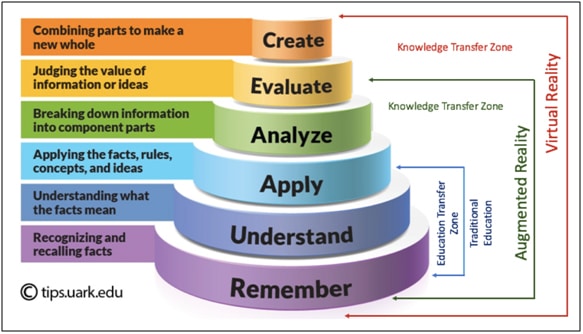Since 1948 Bloom’s Taxonomy of Educational Objectives has been the gold standard of classifying educational goals for student performance evaluationeffective outcomes of education and engagement. The original taxonomy was created by psychologist Benjamin Bloom and has been revised in many different formats. The diagrams below represent various revisions of Bloom’s Taxonomy by different universities[1] over the years. These diagrams are intended to illustrate the levels of engagement and learning that occurs as you move the ‘educational-dial of intelligent engagement’. For the purpose of this article, I have added (overlaid) all text and portions of the diagram that is labeled as traditional education, augmented reality, virtual reality, and knowledge transfer.


The diagrams illustrate that traditional education and learning is accomplished in the lower levels of the taxonomy. This has also been the areas of the taxonomy that the majority of education and learning has comfortably settled in — mainly due to the nature of education transfer versus knowledge transfer. The goal of education transfer is often focused on one’s ability to remember and recall the context of a subject matter and therefore score well in an academic setting. Education transfer is much like a bartering system, whereby the education transferred results in an earned grade or earned a diploma. Education transfer allows both parties to celebrate the end-of-the-journey with a degree and diploma earned.
In contrast, knowledge transfer requires a person to analyze, synthesize, and even create things based on the knowledge that has been transferred to them. Knowledge transfer allows both interested parties to celebrate the fact that there has been a new level of intelligence, knowledge, and competency gained. Whether a person earns a degree or diploma may not matter when the highest outcome is to transfer knowledge and intelligence.
During my career, I have had the privilege and reward of working within corporate training, community colleges, technical colleges, and multiple universities. During my years of experience at numerous education and training entities everyone believes they are adding value to a learner’s life as it relates to Bloom’s Taxonomy. However, often times a debate will start when these same entities argue who is providing the greatest good for learners, the workforce, and citizenship as a whole.
Over the past two years, augmented and virtually has started to ‘bloom’ and impact all learners in a profound way. Augmented and Virtual Reality (AVR) allows all types of education and learning to teach and transfer the entire outcomes within Bloom’s Taxonomy. In other words, AVR has finally bloomed into the mainstream of education and learning. The AVR industry may be estimated as a $120B growth industry, but the real game-changing nature of AVR is for learners around the world. AVR can literally cover the gamut of a liberal arts university becoming a full-fledged industry partner, while at the same time allowing a technical college to excel in areas such as public speaking, management, marketing, and business skills. Eon Reality Inc. the world’s leader in AVR solutions has proven the concept that the outcome of both augmented and virtual reality truly levels the playing field. Not only does AVR level the playing field, it brings together the best in corporate training, education, trade schools, industry, and even municipalities known as ‘Smart Nations and Cities’. For this reason, EON Reality’s Chairman, Dan Lejerskarboldly and emphatically states…“Knowledge is a human right, and by implementing Interactive Digital AVR Hubs along with EON AVR Learn for Life Programs, we are contributing to making knowledge available, affordable, and accessible for everybody on the planet.” It is important to note that Eon Reality Inc. has been delivering AVR for 20-years, has developed the largest learning library of AVR to allow it to ‘Bloom’ wherever it is planted.
Since 1948, educators have been striving to achieve a greater percentage of the objectives within Bloom’s Taxonomy – and that day has arrived. Knowledge can be transferred around the world through AVR. What is most exciting is that the students who are engaged with AVR are the first to benefit from this transformation. Professors, teachers, lecturers, and facilitators of teaching and learning can also engage by using the same teaching modalities they have always used. The mere nature of AVR allows the student experience to take the concept of a flipped classroom to a new level.
Oral Roberts University has implemented an enterprise approach to AVR and was recently featured in the CXOTalk Forum on the transformational nature of AVR for education. The recording and interview can be seen and read at: https://www.cxotalk.com/episode/virtual-reality-innovation-higher-education.
[1] Base Diagram 1 by the University of Arkansas, and BaseDiagram 2 by Iowa State University.




